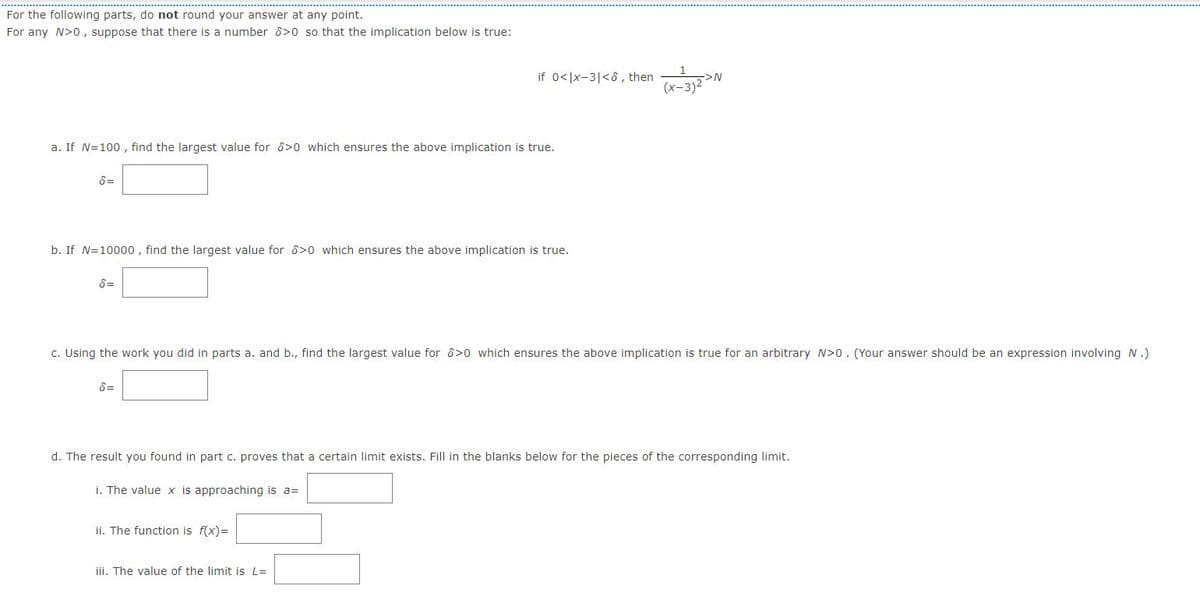For the following parts, do not round your answer at any point. For any N>0, suppose that there is a number 8>0 so that the implication below is true: a. If N=100, find the largest value for >0 which ensures the above implication is true. 8= if 0N b. If N=10000, find the largest value for >0 which ensures the above implication is true. 6= c. Using the work you did in parts a. and b., find the largest value for >0 which ensures the above implication is true for an arbitrary N>0. (Your answer should be an expression involving N.) 6=
For the following parts, do not round your answer at any point. For any N>0, suppose that there is a number 8>0 so that the implication below is true: a. If N=100, find the largest value for >0 which ensures the above implication is true. 8= if 0N b. If N=10000, find the largest value for >0 which ensures the above implication is true. 6= c. Using the work you did in parts a. and b., find the largest value for >0 which ensures the above implication is true for an arbitrary N>0. (Your answer should be an expression involving N.) 6=
Mathematics For Machine Technology
8th Edition
ISBN:9781337798310
Author:Peterson, John.
Publisher:Peterson, John.
Chapter29: Tolerance, Clearance, And Interference
Section: Chapter Questions
Problem 12A
Related questions
Question

Transcribed Image Text:For the following parts, do not round your answer at any point.
For any N>0, suppose that there is a number 8>0 so that the implication below is true:
a. If N=100, find the largest value for >0 which ensures the above implication is true.
8=
b. If N=10000, find the largest value for ô>0 which ensures the above implication is true.
8=
8=
if 0<x-3|<8, then
c. Using the work you did in parts a. and b., find the largest value for 8>0 which ensures the above implication is true for an arbitrary N>0. (Your answer should be an expression involving N.)
i. The value x is approaching is a=
d. The result you found in part c. proves that a certain limit exists. Fill in the blanks below for the pieces of the corresponding limit.
ii. The function is f(x)=
(x-3)2=N
iii. The value of the limit is L=
Expert Solution
This question has been solved!
Explore an expertly crafted, step-by-step solution for a thorough understanding of key concepts.
This is a popular solution!
Trending now
This is a popular solution!
Step by step
Solved in 4 steps with 24 images

Recommended textbooks for you

Mathematics For Machine Technology
Advanced Math
ISBN:
9781337798310
Author:
Peterson, John.
Publisher:
Cengage Learning,

Algebra: Structure And Method, Book 1
Algebra
ISBN:
9780395977224
Author:
Richard G. Brown, Mary P. Dolciani, Robert H. Sorgenfrey, William L. Cole
Publisher:
McDougal Littell

Algebra & Trigonometry with Analytic Geometry
Algebra
ISBN:
9781133382119
Author:
Swokowski
Publisher:
Cengage

Mathematics For Machine Technology
Advanced Math
ISBN:
9781337798310
Author:
Peterson, John.
Publisher:
Cengage Learning,

Algebra: Structure And Method, Book 1
Algebra
ISBN:
9780395977224
Author:
Richard G. Brown, Mary P. Dolciani, Robert H. Sorgenfrey, William L. Cole
Publisher:
McDougal Littell

Algebra & Trigonometry with Analytic Geometry
Algebra
ISBN:
9781133382119
Author:
Swokowski
Publisher:
Cengage

Algebra for College Students
Algebra
ISBN:
9781285195780
Author:
Jerome E. Kaufmann, Karen L. Schwitters
Publisher:
Cengage Learning

College Algebra (MindTap Course List)
Algebra
ISBN:
9781305652231
Author:
R. David Gustafson, Jeff Hughes
Publisher:
Cengage Learning